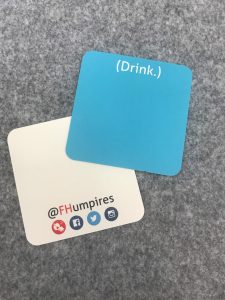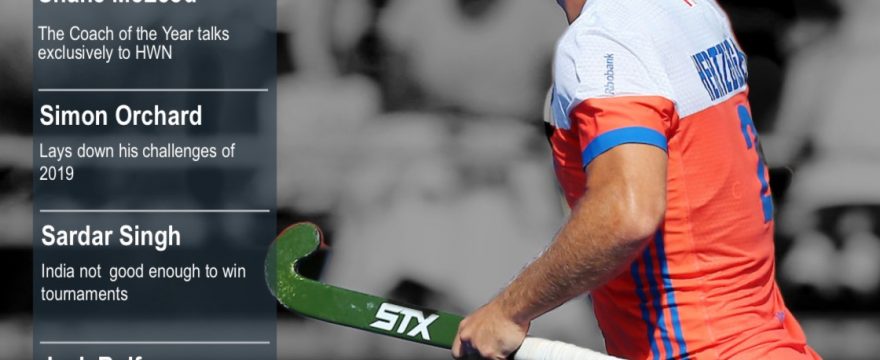Last week on social media the Royal Belgium Hockey Association, which governs the top domestic club competition in the country, announced a new initiative to assist in the promotion of fair play. The response on the platforms, in true social media style, was a mix between ? and ?.

There isn’t a hockey person around who wouldn’t support fair play, especially us umpires charged with ensuring that every match is played fairly and safely. So why the
I believe asking umpires to award blue cards is an awkward way to achieve that goal for
What’s the Plan?
I spoke to top Belgian FIH umpire and energetic custodian of the Belgium Women Umpires initiative (IG: @hockeybelgiumwomenumpires) Céline Martin-Schmets to get a rundown on how the blue card is intended to work.
Targeted to just the highest level of competition with national umpires at the outset, she explained umpires would be looking for “exceptional acts of fair play” like an attacker admitting the goal actually went off their foot. During the game, the umpire would stop time to show the blue card and a ? signal, and after the final whistle send an email to the federation describing the act of fair play.
At the end of the season, the federation will tally up the blue cards and award an as yet undetermined prize to the player and/or team responsible for the most
The umpires will be responsible for noticing “natural reflex” reactions but aren’t to go hunting for reasons to give a blue card.
What is a Blue Card, Anyway?
I’ve heard that good journalists do research, so I fired up the internet knowledge machine to reveal all the truthiness sloppy search terms could reveal about the origins of blue cards. If this is the first time you’ve heard of them, you’ll be surprised to learn it’s part of several sports already worldwide, whether as a long-standing procedure or a newer development to provide needed options for officials.
The blue card can indicate a 2-5 minute suspension in American indoor soccer, beach soccer and junior FA. How about a 1-minute power play in the vaunted Quidditch? Or in beach hockey, it results in a suspension for the remainder of the half for “unsportsmanlike behaviour or for being disorderly/intoxicated on the field/court”.
In futsal, a blue card is for foul play or verbal abuse and results in a rest-of-match disqualification, but no team penalty on the court. In handball, it’s a follow-up to a red card which leads to supplementary discipline against a misbehaving player.
Even in its most innocuous documented form, a blue card in Australia’s National Rugby Championship is used to force potentially concussed players off the pitch for rigorous evaluation.
Boring. Tell Me A Folk Tale!
Enough with the other sports: the most poignant example of a blue card is found in social hockey. Now, I found absolutely zero documentation to support this, but my own anecdotal evidence from a single venture into the world of English festival hockey as all the proof I need.

As a Canadian, I was raised to consider the pitch a forum of solemnity and hard work, but one fateful Easter weekend at the Blackpool Festival changed all that for me.
My brightest memory (not much else is readily recallable for some reason) was watching the umpires hand out blue cards to offending players who either did something hilariously poorly or far too well. Tripping over a blade of grass was an offence equal to showing an unacceptable level of skill in scoring a goal, and it was the umpire’s job to punish both with equal amounts of humour. At the brandishing of a blue card, the player was required to remove themselves from the pitch for the administration of a corrective beverage which triggered another round of banter and added to the fines count later.
Were those ever good times.
The Umpire’s Role
Pop quiz: in each example from another sport mentioned above, what does every usage of the blue card have in common?
Answer: the umpire or referee is imposing a sanction.
Even in the boozy haze of social hockey as described above, the blue card is a penalty. It’s entirely tongue-in-cheek, and perhaps a penalty the player is happy to receive, but a penalty nonetheless. That’s why it works.
At the absolute heart of it, we are impartial, staying out of the way unless the players do something wrong. We can (and do!) appreciate fantastic play, but our applause must stay almost entirely internal, and anything outward is quiet and respectful to the opposing team. Otherwise, we run the genuine risk of looking more in favour of one side or one player than the other. Any show of favour breaks the very foundation of our neutrality.
The very thought of bringing out a card to point out that a player has done something good on the pitch feels…incredibly cringeworthy.
Will It Work?
Let’s turn to the question of effectiveness.
Imagine you’re on the pitch playing in an intense, competitive match. In your defending zone, the ball takes a final and glancing touch off your stick before heading over the end line. That touch goes undetected by the umpire and they award a 15m free hit for your team.
Will you, at that point, choose to turn to the umpire and invite them to reconsider only because that umpire will stop time, pull out a blue card and gain you a round of applause?
Studies have found that even “children spontaneously engage in prosocial and moral actions because they genuinely care about others' well-being and because they want to do what they consider right.” Yup, even kids don’t need a cookie to be good. Giving cookies to adults so they’ll be good is not only unnecessary, it’s condescending.
The Alternative
If Hockey Belgium is concerned about a decline in fair play in their top tier competition, how could they instead address the problem? How can we, in other areas of the world, find our own solutions?
My suggestion: find ways to bring your community together more often, across club lines, school lines, regional lines–whatever separates you, erase that line for something bigger than all of that.
Stick with me for a minute.
Humans, evolutionarily speaking, are driven by the perception of threats. Back in the day, tribes were the people you lived, hunted and gathered with every day. You raised your offspring and defended against predators and environmental threats together. They were genetically similar to you, so they looked like you, spoke like you, acted like you. If you met someone outside your tribe, they probably looked different to you and were warring with you over hunting grounds.
Instinctively we’re still those tribal people with no grounds on which to hunt and no fields in which to gather. We’re stuck with these same survival instincts to treat outsiders as a threat before or conscious brain can even process what’s happening. Throw us in that weird gladiator arena of sport where adrenaline rules and tangible rewards await winners, and we’re bound to growl, lash out and potentially cheat to get the win, which in our lizard brains, is equivalent to slaying the big bison to feed and clothe our tribe for months.
The best way to get over all that weird stuff is to remind us how much we’re all actually on the same side, part of the same big family. How often do you see horrific tragedies bring communities together to rebuild homes, repair relationships and reconnect to each other’s common humanity?
Fundraising for a pitch which everyone will share, or rallying support for a player affected by cancer, or sending a junior performance team to a far-off tournament of a lifetime are examples of causes that bring hockey communities together. Umpires, coaches and administrators are everyday roles every hockey person can perform which will bring them into contact and cooperation with their peers locally, regionally, and internationally. These seemingly mundane interactions are acts of service to the game that illuminate a bigger picture.
The more we see each other as similarly beautiful individuals who may wear a different shirt colour on the day, the more likely we will treat each other with respect and in the manner in which we wish to be treated.
In two words: Fair Play.
So if we want more frequent examples of great sporting behaviour, let’s keep pushing our umpiring programs, our coaching seminars, our board elections. Let’s activate our players in roles outside their teams and their clubs, contributing to goals bigger than just their win or loss on the pitch on a given weekend.
This is how we’ve always built great people and a strong #hockeyfamily. Let’s not lose our way with prizes and plaudits. We’re better than that.
(This article appeared in the Hockey World News Edition 9, February 2019)
